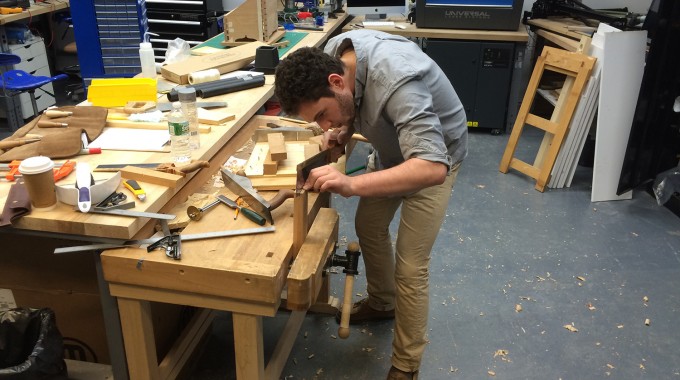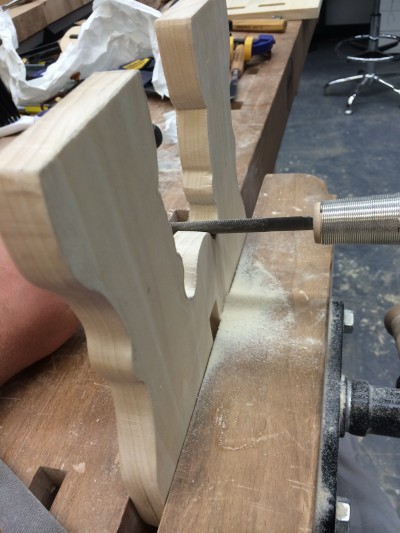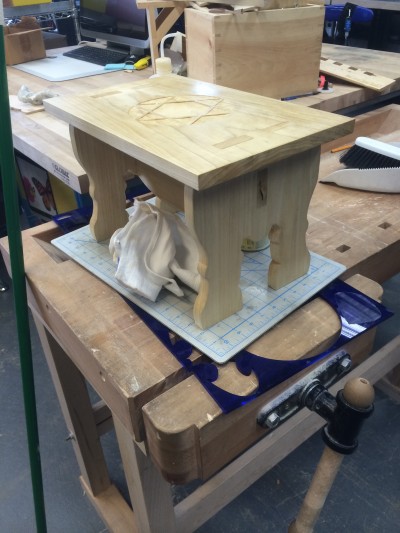If you know of a Columbia College student, faculty member, alumnus/alumna or program we should spotlight, or if you would like to submit a story, please contact:
Columbia College
Office of Communications
cc-comms@columbia.edu

“Creating the stool allowed me to connect with Don Quixote on a deeply personal level — it helped me to discover what Don Quixote meant to me.” — Scott Sonnenberg CC’18
Scott Sonnenberg CC’18 has a passion for woodworking. When his Literature Humanities professor, Seth Ross Kimmel, assistant professor of Latin American and Iberian cultures, announced that he would allow students to make creative projects in place of final papers, Scott embarked on his own quixotic quest to create a stool for Sancho Panza from Miguel de Cervantes’ Don Quixote. In the process he learned more about himself and the crazed knight of La Mancha.
I began woodworking during my senior year of high school, after finishing Donna Tart’s The Goldfinch. In pursuit of becoming just like Hobie, an antique furniture restorer who worked with only traditional methods, I bought old tools on Ebay and practiced rudimentary, centuries-old techniques on scraps of wood that I found in my basement.
When I left for Columbia, along with bedding and clothes, I brought a cardboard box full of chisels, a rusty hand plane and a saw. Soon after I arrived on campus, I discovered the Columbia Maker Space, a newly-dedicated workshop on the 12th floor of Mudd with top-of-the-line woodworking tools that allowed me to continue pursuing my woodworking passion. I started spending the majority of my free time at the woodworking bench, centrally located among racks of wrenches and hammers, a bay of humming 3D printers, and a large drill press.
 Scott refined the curves of the bench’s sides with differently shaped files before finishing them with sand paper. Photo: Scott Sonnenberg CC’18
As my first year progressed, the time I spent making dovetail joints and step-stools remained a vital part of my extracurricular life. And literature, thanks to Literature Humanities, became a central part of my academic life. I came to relish the time I got to spend alone with Homer, Sophocles and Goethe each week as I had with The Goldfinch during my senior year of high school.
Scott refined the curves of the bench’s sides with differently shaped files before finishing them with sand paper. Photo: Scott Sonnenberg CC’18
As my first year progressed, the time I spent making dovetail joints and step-stools remained a vital part of my extracurricular life. And literature, thanks to Literature Humanities, became a central part of my academic life. I came to relish the time I got to spend alone with Homer, Sophocles and Goethe each week as I had with The Goldfinch during my senior year of high school.
But at the end of the year when my professor suggested that in place of an essay, I marry my two interests for my final project, creating an “interpretive stool” inspired by Lit Hum, I was incredulous. I envisioned my hypothetical project, a bench covered in swirling blue paint. “Just like the water in the Aeneid, brilliant,” I thought dismissively, before tossing my imaginary construction onto a heap of imaginary firewood.
As I pondered ideas for a potential essay, however, a construction came to me instead. I envisioned the rotund form of Sancho Panza, Don Quixote’s faithful sidekick in Miguel de Cervantes’ Don Quixote, seated on a throne. In the novel, Sancho, seduced by ballads of knights who reward their squires with governorship of an insula or territory, teams with Don Quixote in expectation of a grand reward for his service. Later in the story, to make fun of his simplicity, a cruel Duke and Duchess make Sancho the governor of an island. To their surprise, Sancho governs remarkably well, though he renounces his throne at the height of his popularity.
And so, for my project, I decided that I would make Sancho Panza a throne of his very own, something that would complement his modest nature while reminding him of his own sage wisdom and the time he spent as governor. After numerous sketches, I turned my proposal into a full-scale formal blueprint for my professor. I drew a simple stool with legs shaped like those of a donkey — a nod to Sancho’s faithful steed — and with a stretcher bulging out like the animal’s belly. On the top, I carved a relief of the Seal of Solomon, a medieval symbol signifying Sancho’s just rule. After the draft was completed, I realized I had just a week-and-a-half to complete the construction and my excitement quickly turned to panic.
When I woodwork, I do not use power tools, which have widely been employed since the early 20th century. Instead, I use what would have been available to an American woodworker in the mid-1700s: only chisels, saws and hand planes (and for this project, regrettably, an electric drill when I could find no manual alternative). I seek to do all of my artisanal wood work by hand, as I have with past hobbies, from Medieval armor reproduction to cake decorating.
 The finished stool after its first coat of shallac. Photo: Scott Sonnenberg CC’18
Ultimately, Sancho Panza’s stool took me nearly 40 hours to complete (though, with the aid of power tools, I likely could have completed the project within an afternoon). As I sweated over my work, chopping square holes in the top with a mallet and chisel and asking myself why I choose to work so inconveniently, I suddenly realized that it was for the same reason that Don Quixote, an impoverished nobleman in a century when knighthood was quickly being forgotten, takes up arms to relive a glorious past. Don Quixote and I, it seems, have both been seduced by the romance of old ways (though Quixote does snap out of it in the end).
The finished stool after its first coat of shallac. Photo: Scott Sonnenberg CC’18
Ultimately, Sancho Panza’s stool took me nearly 40 hours to complete (though, with the aid of power tools, I likely could have completed the project within an afternoon). As I sweated over my work, chopping square holes in the top with a mallet and chisel and asking myself why I choose to work so inconveniently, I suddenly realized that it was for the same reason that Don Quixote, an impoverished nobleman in a century when knighthood was quickly being forgotten, takes up arms to relive a glorious past. Don Quixote and I, it seems, have both been seduced by the romance of old ways (though Quixote does snap out of it in the end).
When I first read Don Quixote, I found it difficult to see beyond his insanity. Every one of his actions seemed impractical and guided on a forgotten ideology. But when I began to work on the interminable stool, he began to make more sense. Quixote and I are both, by definition, quixotic, and while it is perfectly possible that I too am insane, it shows that the tendency to be like Don Quixote is a real human characteristic not lodged in logic, but in an inexplicable yet deep-set passion that can afflict us all. Call me Don Quixote de la Home Depot.
As for Sancho’s throne, I am quite pleased with how it turned out. Like all woodworking done by hand, it’s not perfect — the carving is rough on top, and I see gaps in the joinery that continue to bother me. Nonetheless, I like to imagine presenting Sancho with the stool as a gift and seeing his reaction. Maybe he would place it in the corner of his home and sit on it from time to time, reliving the experience of being governor.
Creating the stool allowed me to connect with Don Quixote on a deeply personal level — it helped me to discover what Don Quixote meant to me. Through my intensive and, some might say, archaic, woodworking ways, I embarked on my own quixotic quest. I struggled through doubt, frustration and setbacks on a seemingly-unending journey not unlike Quixote’s. And in my mind, Don Quixote left the realm of fantasy and ballad, and became a character all too real and all too familiar.